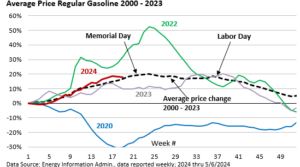An Annual Ritual at the Gas Pump
You’re right if you have this nagging feeling that gas prices rise in the spring. As the graphic illustrates, on average prices rise through Memorial Day, plateau over the summer, and slip in the fall. This year is no exception, as prices echo the seasonal pattern.

Since 2000, one glaring exception occurred in 2020, as prices fell amid lockdowns tied to Covid.
According to the Energy Information Administration, the average price of regular gasoline this year bottomed at $3.06 in January. As of the last reporting date, the price averaged $3.64 on May 6.
What’s behind the seasonal drift in prices?
Summer blends used to reduce smog cost more. And the changeover occurs as the summer driving season, which boosts gasoline demand, gets underway. It’s a double whammy for drivers.
Also, partly due to instability in the Middle East, oil prices are up this year, though prices are off the 2024 high.

Since we are discussing gasoline prices, let’s address one more thing. Oil prices jump, and the cost of gasoline seems to follow quickly. Then, oil comes back down, but the decline at the pump seems agonizingly slow.
Economists call it “asymmetric pass-through.” Those in the oil industry call it “rockets and feathers.” That is to say, prices rise like a rocket and drop like a feather. The issue bedevils drivers.
A detailed review by the Federal Reserve Bank of St. Louis concluded, “The market for gasoline is local, with variations in market concentration, demand, regulation, and taxation.”
In plain English, “Opportunities exist for retailers to take advantage of price changes to maintain a higher overall profit,” the authors noted, as they “adjusted prices downward slower because consumers were already accustomed to the higher prices.”

